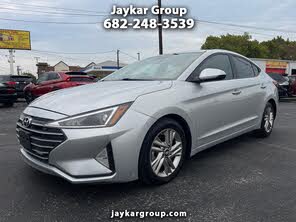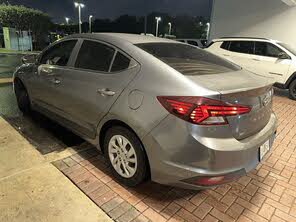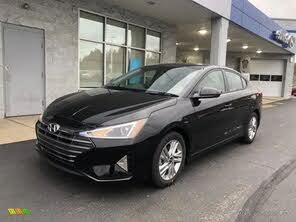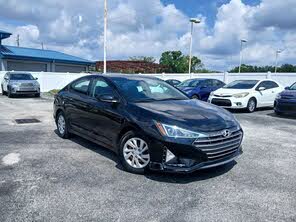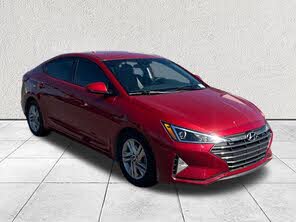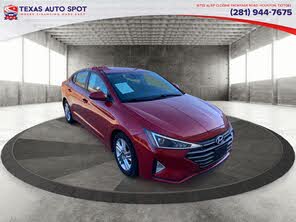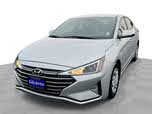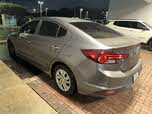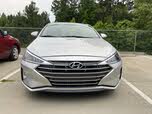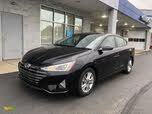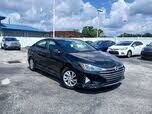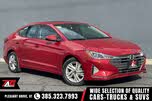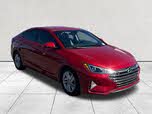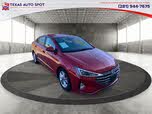2019 Hyundai Elantra vs 2020 Hyundai Elantra
Overview | |
MSRP$17,200 | MSRP$19,300 |
Listings739 | Listings1052 |
Ratings & Reviews | |
User Reviews | User Reviews |
Expert reviews8.2 out of 10 | Expert reviews8.3 out of 10 |
Pros
Cons
| |
2019 Hyundai Elantra Reviews SummaryCustomer satisfaction is dependent on multiple factors. For example, let's say you go out to a new restaurant. Even if the service is great, or the bill is inexpensive, or the restaurant has a lovely ambiance, you probably won't go back if the food doesn't taste good. The updated and upgraded 2019 Hyundai Elantra is like that—unless you buy the turbocharged Sport trim. | |
2020 Hyundai Elantra Reviews SummaryHyundai isn’t pulling any punches when it comes to the compact car segment, where value is of utmost importance. And though a completely redesigned 2021 Elantra is coming soon, the automaker bestows several value-enhancing improvements upon the outgoing 2020 Hyundai Elantra compact sedan. They include free scheduled maintenance, improved fuel economy ratings, and new standard safety features. | |
No video found | |
Popular Features & Specs | |
Engine2.0L 147 hp I4 | Engine2.0L 147 hp I4 |
Drive TrainFWD | Drive TrainFWD |
Seating Capacity5 | Seating Capacity5 |
Horsepower147 hp @ 6200 rpm | Horsepower147 hp @ 6200 rpm |
MPG City26 | MPG City31 |
MPG Highway36 | MPG Highway41 |
Engine | |
Engine Name2.0L 147 hp I4 | Engine Name2.0L 147 hp I4 |
Torque132 lb-ft @ 4500 rpm | Torque132 lb-ft @ 4500 rpm |
Horsepower147 hp @ 6200 rpm | Horsepower147 hp @ 6200 rpm |
DrivetrainFWD | DrivetrainFWD |
Fuel Economy | |
MPG City26 | MPG City31 |
MPG Highway36 | MPG Highway41 |
Interior | |
Seating Capacity5 | Seating Capacity5 |
Safety | |
Front Crash Overall4 | Front Crash Overall4 |
Side Crash Overall4 | Side Crash Overall4 |
Dimensions & Capacity | |
Cargo Space14.4 cu ft | Cargo Space14.4 cu ft |
Curb Weight2972 lbs | Curb Weight2844 lbs |
Height56.5 in | Height56.5 in |
Length181.9 in | Length181.9 in |
Width70.9 in | Width70.9 in |
Wheelbase106.3 in | Wheelbase106.3 in |
Maximum Payload | Maximum Payload1080 lbs |
Number of doors4 | Number of doors4 |
Overview | ||
MSRP | $17,200 | $19,300 |
Listings | ||
Ratings & Reviews | ||
User reviews | ||
Expert reviews | 8.2 out of 10Read full review | 8.3 out of 10Read full review |
Pros & cons | Pros
Cons
| |
Summary | Customer satisfaction is dependent on multiple factors. For example, let's say you go out to a new restaurant. Even if the service is great, or the bill is inexpensive, or the restaurant has a lovely ambiance, you probably won't go back if the food doesn't taste good. The updated and upgraded 2019 Hyundai Elantra is like that—unless you buy the turbocharged Sport trim. | Hyundai isn’t pulling any punches when it comes to the compact car segment, where value is of utmost importance. And though a completely redesigned 2021 Elantra is coming soon, the automaker bestows several value-enhancing improvements upon the outgoing 2020 Hyundai Elantra compact sedan. They include free scheduled maintenance, improved fuel economy ratings, and new standard safety features. |
Video | No video found | |
Popular Features & Specs | ||
Engine | 2.0L 147 hp I4 | 2.0L 147 hp I4 |
Drive Train | FWD | FWD |
Seating Capacity | 5 | 5 |
Horsepower | 147 hp @ 6200 rpm | 147 hp @ 6200 rpm |
MPG City | 26 | 31 |
MPG Highway | 36 | 41 |
Engine | ||
Engine Name | 2.0L 147 hp I4 | 2.0L 147 hp I4 |
Torque | 132 lb-ft @ 4500 rpm | 132 lb-ft @ 4500 rpm |
Horsepower | 147 hp @ 6200 rpm | 147 hp @ 6200 rpm |
Drivetrain | FWD | FWD |
Fuel Economy | ||
MPG City | 26 | 31 |
MPG Highway | 36 | 41 |
Interior | ||
Seating Capacity | 5 | 5 |
Safety | ||
Front Crash Overall | 4 | 4 |
Side Crash Overall | 4 | 4 |
Dimensions & Capacity | ||
Cargo Space | 14.4 cu ft | 14.4 cu ft |
Curb Weight | 2972 lbs | 2844 lbs |
Height | 56.5 in | 56.5 in |
Length | 181.9 in | 181.9 in |
Width | 70.9 in | 70.9 in |
Wheelbase | 106.3 in | 106.3 in |
Maximum Payload | 1080 lbs | |
Number of doors | 4 | 4 |
The 2019 Hyundai Elantra underwent a significant styling overhaul, with updates to its front-end design, new wheels, and a revamped rear that included a new trunk lid, taillights, and rear bumper. The facelift was a shift from an upscale, conservative design inspired by the Genesis G80 sedan to something more kaleidoscopic and geometric. While the new aesthetic certainly made a statement, it was a hit or miss, polarizing opinions on its appeal.
Inside, the 2019 Elantra’s cabin saw subtle yet impactful enhancements. The air vents received a design upgrade, some plastic components featured a carbon-texture finish, and the gauges and center dashboard controls were revised for better visual appeal. Despite some materials still appearing inexpensive, the overall build quality was commendable, with tightly screwed-together parts.
The Elantra offered a variety of models. The sedan came in SE, SEL, Value Edition, Eco, and Limited trims, starting at $17,100 plus $885 for destination. The Limited trim of the 2019 model included enhancements like adaptive cruise control, forward-collision warning, pedestrian detection, automatic emergency braking, and more, thanks to the optional Ultimate Package. This package, along with other features, bumped the price of the test vehicle to $26,690, including destination charges.
In contrast, the 2020 Hyundai Elantra retained the bold design introduced in 2019, with no visual changes. The angular geometric-influenced styling aimed to pave the way for the dramatically new look anticipated in the 2021 model. Available in the same trims as the 2019 version - SE, SEL, Value Edition, Eco, Limited, and Sport - the 2020 Elantra continued to showcase its angular headlight, fog light, and wheel designs, highlighting them more prominently under a black paint job. The 2020 Limited test vehicle’s window sticker sat at $27,630, including a $975 destination charge, reflecting the addition of features from the Ultimate Package and a set of floor mats.
Inside, the 2020 Elantra's updates aimed to enhance the upscale feel introduced in 2019. Silver trim details on various controls and areas like the steering wheel and engine start button added a touch of elegance. The 2020 model's cabin continued to balance high-quality finishes with the inevitable presence of some harder, glossier plastics, reminding drivers that this remained a mainstream compact car.











Performance-wise, the 2019 Hyundai Elantra was equipped with a 2.0-liter 4-cylinder engine producing 147 horsepower, paired with a 6-speed automatic transmission driving the front wheels. While acceleration was adequate, the focus was on providing a balanced driving experience with Normal, Sport, and Smart driving modes. However, the Smart mode’s perceptiveness was limited, and Sport mode, while livelier, added unwelcome heft to the steering. Most drivers likely kept the car in Normal mode, finding it satisfactory for everyday use. The ride quality was decent but disrupted by the less sophisticated torsion-beam rear-axle suspension, resulting in a busy ride at times. The car delivered a combined 32 mpg as per EPA estimates, though real-world testing yielded 29.3 mpg on a modified testing loop.
In 2020, the Elantra introduced a significant change under the hood with a new continuously variable transmission (CVT) replacing the 6-speed automatic. The 2.0-liter 4-cylinder engine remained, delivering the same 147 horsepower. The CVT, termed "Intelligent Variable Transmission" by Hyundai, simulated gear shifts to mimic a traditional automatic, providing a smoother experience. Despite the promise of improved efficiency, the real-world fuel economy for the 2020 Elantra came in at 29.3 mpg on the testing loop, slightly below the 34 mpg EPA rating.
Specialty models like the Elantra Eco featured a 1.4-liter turbocharged engine delivering 128 horsepower and better torque, coupled with a 7-speed dual-clutch automatic transmission for a rated 36 mpg combined. The Elantra Sport, with a 1.6-liter turbo engine producing 201 horsepower, promised a more enjoyable drive, thanks to its independent rear suspension. This sportier setup provided a firmer yet superior ride quality compared to the standard beam-axle setup.
The 2019 Hyundai Elantra offered front-seat comfort suitable for most occupants, with both driver and front passenger seats featuring height adjustment. Higher trims included heated seats and a leather-wrapped steering wheel. However, the rear seats were less accommodating, with hard plastic front seatbacks and a lack of air conditioning vents and USB ports for rear passengers. Interior storage was practical, with a sizable center-console bin and glove box, and a smartphone tray with optional wireless charging in the Limited trim. The trunk’s 14.4 cubic feet of space was generous for a compact car, and the hands-free Smart Trunk feature added convenience.
For 2020, the Elantra maintained its spacious and comfortable front seating, with power adjustments in the Limited trim. Leather upholstery and a sliding center console armrest enhanced comfort. The lack of rear air conditioning vents persisted, but the trunk remained impressive at 14.4 cubic feet, matching the capacity of the 2019 model. Additional thoughtful features like the interior grab handle inside the trunk lid made closing it easier.
In the 2019 Elantra, opting for any trim above the base SE brought a 7-inch touchscreen infotainment system with Apple CarPlay, Android Auto, and satellite radio. The Limited trim saw an upgrade to an Infinity premium sound system and, with the Ultimate Package, an 8-inch display with navigation and SiriusXM Data Services. The infotainment system's user-friendliness was enhanced by sufficient physical controls, and the sound quality of the Infinity system was notable for a compact car.
The 2020 Elantra continued with similar technological offerings. The base SE trim included a 5-inch display, while the SEL trim upgraded this to a 7-inch touchscreen with Apple CarPlay, Android Auto, and satellite radio. Higher trims like the Value Edition came with a complimentary Blue Link subscription for three years. The Limited trim added wireless smartphone charging and maintained the Infinity premium sound system. The Ultimate Package bumped the display to 8 inches and added navigation and additional Blue Link services. The system’s physical controls and intuitive layout made it easy to use, while the enhanced sound system continued to impress.
In 2019, the Elantra's SEL trim and above included a suite of driver-assistance features like forward-collision warning, automatic emergency braking, lane-departure warning, and lane-keeping assist. Higher trims like the Limited added adaptive cruise control, pedestrian detection, automatic high beams, and a Safe Exit system. These features helped the Elantra earn top marks from the IIHS, except for an Acceptable rating for LATCH child-seat anchor accessibility. The NHTSA, however, rated the Elantra with four stars overall.
For 2020, Hyundai made Smart Sense standard across all Elantra trims. This package included forward-collision warning, automatic emergency braking, lane departure warning, lane-keeping assist, and a driver attention monitor. Starting with the SEL trim, blind-spot warning and rear cross-traffic alert were added, while the Limited and Sport trims featured full LED headlights with automatic high beams. The Ultimate Package enhanced safety further with adaptive cruise control and pedestrian detection. Although real-world performance of the ADAS was accurate, it lagged in refinement. The Elantra achieved a Top Safety Pick from the IIHS when equipped with LED headlights and retained a four-star overall rating from the NHTSA.
CarGurus highlights

According to CarGurus experts, the overall rating for the 2019 Hyundai Elantra is 8.2 out of 10, while the 2020 Hyundai Elantra scores 8.3 out of 10. Based on these ratings, the 2020 Hyundai Elantra slightly edges out the 2019 model, thanks to the standardization of advanced safety features, the introduction of a more efficient CVT, and continued interior and technological improvements. While both models offer great value, the 2020 Elantra's small advancements make it the better choice in this comparison.
Choose the 2019 Hyundai Elantra if:
- You prefer a more balanced driving experience with a traditional 6-speed automatic transmission.
- You seek a lower starting price and a range of trim options to fit your budget.
- You value comprehensive driver-assistance features, especially with the Ultimate Package on the Limited trim.
Choose the 2020 Hyundai Elantra if:
- You favor the latest transmission technology with a smoother CVT setup that aims to enhance fuel efficiency.
- You want advanced safety features standard across all trims, providing peace of mind at every level.
- You look for slight interior enhancements and additional comfort features in higher trims.
CarGurus highlights

According to CarGurus experts, the overall rating for the 2019 Hyundai Elantra is 8.2 out of 10, while the 2020 Hyundai Elantra scores 8.3 out of 10. Based on these ratings, the 2020 Hyundai Elantra slightly edges out the 2019 model, thanks to the standardization of advanced safety features, the introduction of a more efficient CVT, and continued interior and technological improvements. While both models offer great value, the 2020 Elantra's small advancements make it the better choice in this comparison.
Choose the 2019 Hyundai Elantra if:
Shop Now- You prefer a more balanced driving experience with a traditional 6-speed automatic transmission.
- You seek a lower starting price and a range of trim options to fit your budget.
- You value comprehensive driver-assistance features, especially with the Ultimate Package on the Limited trim.
Choose the 2020 Hyundai Elantra if:
Shop Now- You favor the latest transmission technology with a smoother CVT setup that aims to enhance fuel efficiency.
- You want advanced safety features standard across all trims, providing peace of mind at every level.
- You look for slight interior enhancements and additional comfort features in higher trims.

By: CarGurus + AI
At CarGurus, our team of experienced automotive writers remain at the heart of our content operation, conducting hands-on car tests and writing insightful guides that are backed by years of industry experience. To complement this, we are harnessing AI to make our content offering more diverse and more helpful to shoppers than ever. To achieve this, our AI systems are based exclusively on CarGurus content, ratings and data, so that what we produce is both unique to CarGurus, and uniquely helpful to car shoppers.




